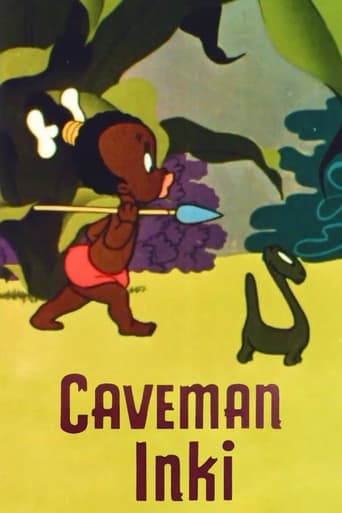

In the tradition of Wille E. Coyote and Roadrunner, there is no dialogue and the action speaks louder than words. Inki the hunter was going to hunt a dinosaur, but instead goes after the Mynah Bird leading them in a series of wacky events. It is a great cartoon, the dinosaurs are interesting to look at and the animation is great, not to mention the music. But with every up there is a down. It is politically incorrect. First of all, the character is offensive to look at and is bound to cause an uproar. There are some running gags there. It must be seen to be believed. Give it a watch. Although it is not rated, but a G-rating would be nice.
... View More"Caveman Inki" and at least four other Inki cartoons have been shelved by Warner Brothers (home of Merrie Melodies/Looney Tunes) because the character offends modern sensibilities. So, although audiences of the 1940s and 50s saw no problem with this depiction of a black character with huge lips and a bone in his hair, today it is bound to offend. While this is true, I have to see any cartoon banned (officially or unofficially) for many reasons. First, we need to know how far we've come--and, thankfully, this sort of character is something we wouldn't make today because most folks genuinely don't want to offend. Second, throwing out the entire cartoon is a loss of our history. And, in some cases, the cartoons are good even though they do offend. However, "Caveman Inki" isn't that good--it just isn't funny. Plus the myna bird character was used pretty much the same way seven years earlier. Not a terrible cartoon but one we probably won't miss as it sits on the shelf.
... View More...that "Caveman Inki" was a product of the old Euro-American view of Africa, given how they draw Inki. As long as we understand that, it's a pretty fun cartoon, as he persists in his attempts to trap the mysterious minah bird - with its syncopated walk - and gets chased by a lion. The whole scene in the dinosaur's belly is quite cool.If they eventually release these cartoons on DVD, I figure that they'll probably have to give some sort of disclaimer identifying that they never meant any malice to people of African descent; they just didn't know any better. As it was, this cartoon seemed like a sort of place holder in between the really great ones (in 1950, Chuck Jones also released "The Scarlet Pumpernickel" and "Rabbit of Seville"). Worth seeing.
... View MoreChuck Jones clearly liked using classical music. In this cartoon he used the same mysterious, black, myna bird as he did in several other cartoons.The bird, (whose appearance signaled a stop to whatever fighting was going on) was always accompanied by the same melodic phrase by the classical composer, Felix Mendelssohn. Anyone familiar with the works of Mendelssohn will recognize the music immediately. And, I suspect the reverse will also be true, i.e. anyone having seen the huge, black myna bird, with the bored expression, doing his silly hop to the music of Mendelssohn, will find it difficult to listen to this music again without conjuring up a memory of this curious bird.
... View More